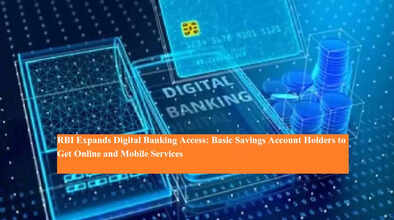RBI Expands Digital Banking Access: Basic Savings Account Holders to Get Online and Mobile Services

In a major step toward strengthening financial inclusion in India, the Reserve Bank of India (RBI) has announced that Basic Savings Bank Deposit Account (BSBDA) holders will now have access to full-fledged digital banking facilities. The announcement was made by RBI Governor Sanjay Malhotra on October 1, 2025, during the release of the central bank’s latest monetary policy.
Until now, digital banking services such as mobile and internet banking were largely reserved for regular savings account holders. With this change, millions of Indians holding basic savings accounts will soon be able to use online banking services, marking a significant milestone in the country’s journey toward digitization of financial services.
A Festive Season Gift from RBI
Speaking at the press briefing, Governor Malhotra said the move would allow basic account holders to access banking facilities conveniently from their homes. “Enabling digital services on BSBDA accounts will make banking more accessible, especially for people in rural and semi-urban areas. This is a major step toward deepening financial inclusion in India,” he noted.
At present, BSBDA accounts come with limited features such as deposit and withdrawal facilities, the ability to make payments through electronic channels, and free ATM cards. However, these accounts lacked mobile or internet banking access. By expanding services, RBI is bridging this digital divide and ensuring that even entry-level account holders can enjoy the same digital benefits as mainstream customers.
Why This Matters for Financial Inclusion
The RBI had introduced the concept of Basic Savings Bank Deposit Accounts to bring more people under the formal banking system. These accounts come with several advantages:
-
No minimum balance requirement.
-
Free access to basic banking services.
-
Free ATM-cum-debit cards issued by banks.
-
Easy accessibility, especially for low-income individuals.
By adding digital facilities, RBI is empowering millions of households who previously had to visit branches or ATMs for even simple transactions. This aligns with the government’s broader push for Digital India and ensures that the benefits of modern banking reach every section of society.
Part of a Wider Push for Digital Banking
Governor Malhotra highlighted that digitization in India’s banking sector is progressing rapidly, and extending online facilities to BSBDA accounts was the “logical next step.” With the growing adoption of UPI (Unified Payments Interface), mobile wallets, and internet-based transactions, it had become necessary to allow even the most basic account holders to participate fully in the digital economy.
Analysts believe this move will not only reduce the dependency on cash but also promote safe, transparent, and quick financial transactions. For millions of migrant workers, daily wage earners, and rural families, access to mobile and internet banking can be transformative, reducing time and travel costs associated with traditional banking.
Monetary Policy Announcement: No Change in Repo Rate
Alongside this announcement, the RBI also unveiled its monetary policy decision. The central bank has once again kept the repo rate unchanged, marking the second consecutive policy review without a rate cut. The repo rate currently stands at 5.5%, down from 6.5% earlier this year.
RBI had previously reduced rates by 25 basis points each in February and April, and by 50 basis points in June, totaling a 100 bps (1%) cut so far in 2025. The decision not to alter rates this time was in line with economists’ divided expectations.
While unchanged repo rates mean there will be no immediate relief for home loan or car loan borrowers, experts expect a possible 25-bps cut in December’s policy review if inflation remains under control.
Looking Ahead
The RBI’s decision to expand digital banking access to BSBDA accounts has been welcomed across the financial sector. Experts say the move will accelerate financial inclusion, particularly in rural areas where millions of people rely on basic savings accounts.
By removing the digital barrier, the central bank is not only empowering individuals but also supporting the broader goal of creating a cash-lite, digitally empowered economy. For customers, this means greater convenience, better financial management, and more control over their money.
As India continues its push toward a digital-first financial ecosystem, RBI’s announcement ensures that no section of society is left behind in the transformation.

